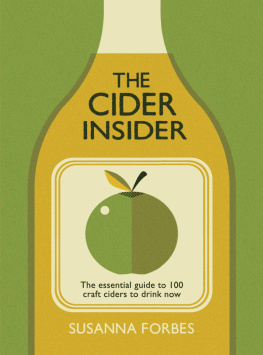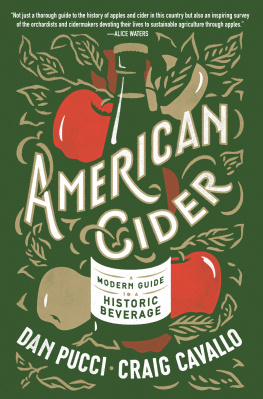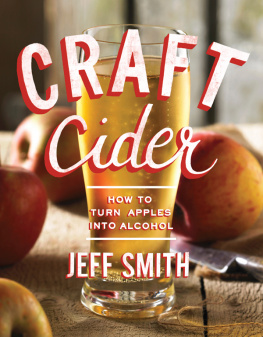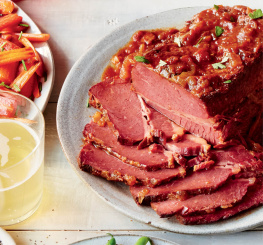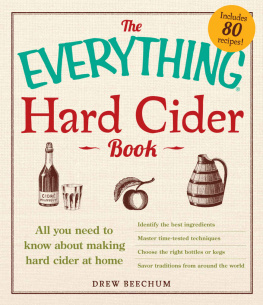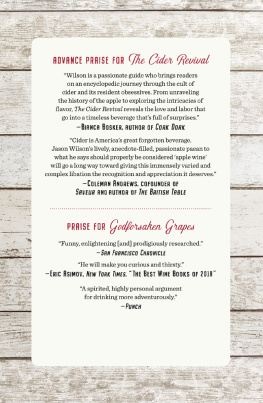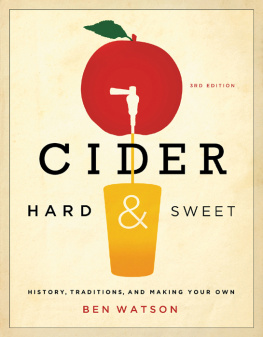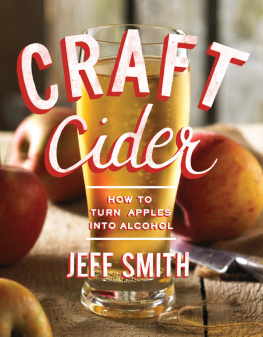
For Sally, for everything.
Text copyright 2015 by Jeff Alworth.
Illustrations copyright 2015 by Chronicle Books LLC.
All rights reserved. No part of this book may be reproduced in any form without written permission from the publisher.
Library of Congress Cataloging-in-Publication Data:
Alworth, Jeff.
Cider made simple : all about your new favorite drink / Jeff Alworth ; Illustrations by Lydia Nichols.
pages cm
Includes bibliographical references and index.
ISBN 978-1-4521-3445-1 (hc)
ISBN 978-1-4521-4391-1 (epub, mobi)
1. Cider. I. Title.
TP563.A62 2015
663'.63dc23
2014038357
Designed by Ryan Hayes
Chronicle Books LLC
680 Second Street
San Francisco, California 94107
www.chroniclebooks.com

H ow simple and natural, how elemental is cider? This is how you make it: liberate the juice from the fruit. Thats itcider makes itself.
In fact, anyone with an apple tree knows you dont even have to liberate the juice. Ive watched it happen in my front yard. In the late summer, tart little seedling apples begin to make a carpet under the gnarled tree out there. A scent rises from them, heady and sharp. This is an ancient aroma, and for millions of years, creatures like me have been drawn to it. On each of my apples stippled red skins is a film of natural yeast, and every time this protective coating tears or rupturesthanks to the violence brought by insects and gravitymillions of tiny creatures pour in to snack on the sugars inside and work their fermentation magic.
In the United States, were a little confused about what cider is. We think of it as that sweet, cloudy stuff that comes in large glass jugs. Thanks to Prohibition, Americans developed a taste for what should properly be called sweet cider, which is really just apple juice. Once temperance kicked in, farmers began selling the juice from their orchards immediately after pressing and it became a seasonal treat. In the centuries before that, they would let the juice rest in casks and naturally ferment, preserving their bounty to be consumed slowly, over the cold winter monthsa fermented beverage everyone else in the world calls cider (or cidre [French], sagardoa [Basque], or sidra [Spanish]).
In the United States, fermented cider is often called hard, a designation that carries two separate judgments. If cider is the sweet stuff and hard cider the fermented, our naming schemes suggest that the sweet juice is the natural, unqualified state. But anyone who has allowed a jug of farm-fresh juice to sit too long in their fridge knows this isnt true. In New England, where my wife grew up drinking sweet cider in mid-autumn, jugs are emptied speedily, lest the cider develop a spiky, tingling quality usually described as off. Cider is the final state, the completed state; juice is an embryonic phase early in a natural process.
Dont call it hard. Fermented apple juice is cider, just cider.

Why Apples?
If fruit naturally transforms itself into alcohol, why do people make cider from apples? The reason has to do with all the stuff that doesnt ferment. Sugar becomes alcohol, but what gives good fruit wines their flavor and balance are other compounds, particularly acids and tannins. Grapes have them, as do pears (which can be made into a cider-like drink called perry), but not strawberries or lychees. Indeed, unlike sweet eating fruits such as cherries, peaches, and oranges, apples come in different types that accentuate these qualities: sweet eating apples like Red Delicious, tart apples like Granny Smith, and bitter apples used only in ciderwith names like Yarlington Mill, Michelin, and Frequin Rouge. Other apples may be used to round out a cider by adding aroma or other flavor notes, especially those tart ones, but the most complex ciders begin with bitter apples. Except for the grape, no fruit takes to fermentation so well as the humble apple.
Blended together and fermented, these different apple varieties have the capacity to produce a beverage that is crisp and complex, full of flavors we never associate with the fresh fruit: pepper, lemon, elderflower, cedar, and soil. A cider may be delicate and vinous or have a touch of funkiness with flavors like cheese, vinegar, or Band-Aid.
The Holy Trinity: Acid, Tannin, and Sweetness
To the extent philosophers have deigned to direct their attention to the aesthetics of flavor (yes, there are such people), their gaze has settled on wine, not cider. They use words like hitherto and focus on elements like expressiveness as the key to vinous aesthetics. Cider contains many of the same elements wine does, but I would argue for a more grounded basis for judgment: Balance. Humans love flavorour prefrontal cortex developed to appreciate itand we can fall into a sensual frenzy over tastes as seemingly offensive as pungent fish eggs, fiery habaneros, or stinky cheese. What we look for in any food or drink, no matter how potent any single quality, is balancethe harmony of contrasting or complementary flavors. The most prized foods and drinks are those that use layers of flavor together to create a single, lush impression, like a note sung by a choir.
In cider, this balance is achieved with acidity, tannins, and sweetness. A cider doesnt have to contain all three nor must they be present in equal intensity. But to create a complexity of the palate (enough flavor) on the one hand yet avoiding falling into imbalance (too much flavor), these basic elements must create a structure for the cider.

ACIDITY
Apples get their tart zip from malic acid. All ciders need acid to create a sense of crisp liveliness; acids brighten flavor and provide a sense of mouthfeel. Without acid, a cider will taste dull and flabby. Some ciders, like English scrumpy and those made in Spain, develop additional acid during fermentation. In terms of balancing cider, acid cuts through sugar and heightens tannin.
TANNINS
In chemical terms, tannins are polyphenols and associated phenolic acids, but to the tongue they are the quality of bitterness and astringency of a kind found in oversteeped tea. Tannins also give the impression of dryness. Many ciders are low in tannins, but they can help provide a contrasting depth in the way hops offset malt in beer.
SWEETNESS
The final element is often one of the least assertive. Because sugars get converted to alcohol, many ciders have few remaining sugars. They provide a sense of fullness that buffers acid, alcohol, and tannin. The sense of sweetness may also derive from fermentation or be subtly suggested by other aroma or flavor compounds in the apple.
Further Layers
Sweetness, acidity, and tannins are but the skeleton of a ciderto appreciate the fullness of its palate, we must look at the seductive curves of its fleshthe flavors, aromas, and textures that give cider its sensual delights. When you put your nose over the rim of a glass and snuffle, you may inhale the aroma of a forest floor, full of mushrooms and cedar boughs, or perhaps something brighter, more like an ocean breeze filtered through a lemon grove. Cider is made of apples, but it doesnt always taste like apple, and rarely
Next page

